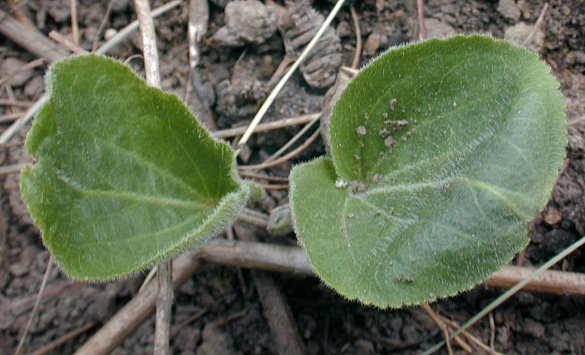Description: This wildflower consists of a low rosette of basal leaves up to 6" across; a mature plant will produce one or more flowering stalks about ½–1' tall. The blades of the basal leaves are up to 3" long and 2½" across; they have stout hairy petioles up to 1½" long. The basal leaves are more or less oval in shape, crenate along their margins, palmately veined, and hairy on both their upper and lower surfaces; the upper surface of each leaf is medium green, while the lower surface is pale green or pale purplish green. Each flowering stalk is stout, erect, terete, light green, and very hairy; it has small alternate leaves up to 1¼" long and ½" across, which become gradually smaller as they ascend toward the inflorescence. The alternate leaves are similar to the basal leaves, except they are ovate in shape and smaller in size. Each alternate leaf is sessile or it clasps the stalk.

The inflorescence consists of a stout spike of small flowers about 2-6" long. These flowers are densely clustered along the spike, facing in all directions. Underneath each flower, there is a small leafy bract that is lanceolate. Each flower has a 2-lipped corolla that is cream-colored or pale yellow, and a calyx consisting of 4 green sepals that are elliptic and hairy. The corolla is about 5 mm. long and slightly longer than the calyx; the upper lip of the corolla is unlobed, while the irregular lower lip is unlobed or divided into 2-3 lobes. Each flower has a pair of exserted stamens and a slender white style. The blooming period occurs from mid-spring to early summer, lasting about 3 weeks for a colony of plants. The flowers bloom gradually from the bottom of the spike to its apex. Afterwards, the flowers are replaced by small 2-celled seed capsules; each capsule contains several seeds. The root system consists of a cluster of coarse fibrous roots; an older plant may form a small caudex. This wildflower occasionally forms colonies at favorable sites.

Cultivation:
The
preference is full sun, dry conditions, and a barren acidic soil that
is sandy or gravelly. Partial sun is also acceptable. This wildflower
grows slowly and doesn't tolerate competition from taller, more
aggressive plants. It is adaptable to sunny rock gardens and there are
few problems with pests and disease.
Range & Habitat:
The native Kittentails is restricted to the west-central and northwest
sections of
Illinois, where it is rare (see Distribution
Map). This wildflower is state-listed as 'threatened.'
Habitats include dry sand prairies, dry gravel prairies, hill prairies,
barren savannas, thinly wooded bluffs, and sandy or gravelly
riverbanks. This species is restricted to high quality habitats in
natural areas; it is endemic to the Midwest and uncommon throughout its
range.

Faunal
Associations:
The flowers are cross-pollinated by small bees, especially Halictid
bees that seek nectar and/or pollen. The following Halictid bees
have been observed to visit the flowers of Kittentails: Auglochlorella striata,
Lasioglossum anomalum,
and Lasioglossum
vierecki (McKone et al., 1995; Moure & Hurd,
1987). Additional information about floral-faunal relationships is
unavailable.
Photographic Location:
The wildflower garden of the webmaster in Urbana, Illinois.
Comments:
While not particularly showy, Kittentails is an unusual little plant.
It resembles some broad-leaved Plantago spp.
(Plantains), but the floral spike of Kittentails is more stout and its
flowers are insect-pollinated. The closest relatives (either Besseya
spp. or Synthyris spp.) are found in
mountainous areas of the western states. These latter species usually
have
flowers (or floral bracts) that are purple, otherwise they are similar
in appearance to their eastern counterpart. Another scientific name of
Kittentails is Wulfenia bullii.